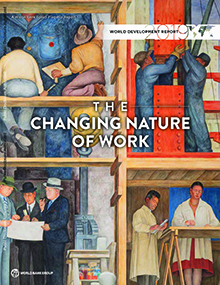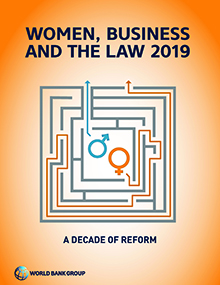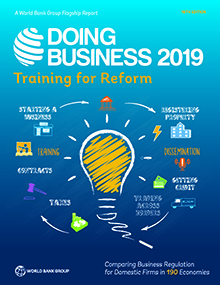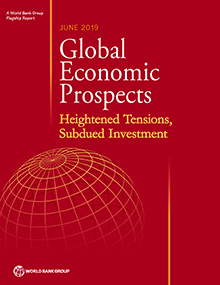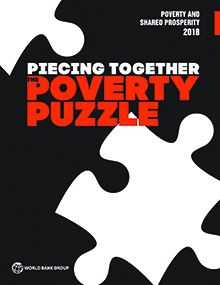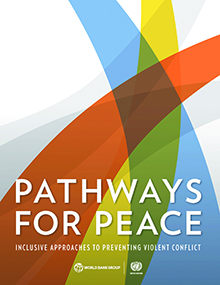Knowledge is central to the World Bank’s ability to influence the global development agenda. Combining global and country knowledge, our research programs generate wide-ranging insights for solving development challenges in client countries.
We share our research through reports and publications, in-depth analytic services, and freely available development data. In fiscal 2019, the Bank published reports on pressing topics, including:
World Development Report 2019: The Changing Nature of Work. This flagship report investigates how the nature of work is changing due to advances in technology. The report points out that technological progress is constantly reshaping work and the demand for skills. It suggests that governments need to prioritize investments in human capital to ensure that workers can build the right skills. In addition, governments need to enhance social protection and extend it to all people in society, regardless of the terms on which they work.
Women, Business and the Law 2019: A Decade of Reform. This report examines laws and regulations affecting women’s prospects as entrepreneurs and employees across 187 economies. It seeks to inform policy discussions on how to remove legal restrictions on women and to promote research on ways of improving women’s economic inclusion. The 2019 edition introduces a new index measuring legal rights for women at milestones throughout their working lives. The data cover a 10-year period to shed light on the current situation, as well as how laws affecting women’s equality of opportunity have evolved over time.
Doing Business 2019: Training for Reform. Using quantitative indicators, Doing Business compares business regulation and the protection of property rights across 190 economies and over time. Each year, the report identifies 10 economies that made the most notable improvements over the previous year in the areas measured. The 2019 edition gives this distinction to Afghanistan, Djibouti, China, Azerbaijan, India, Togo, Kenya, Côte d’Ivoire, Turkey, and Rwanda. It also finds that a third of all business regulation reforms recorded for the year were in Sub-Saharan Africa.
Global Economic Prospects. This semiannual flagship report, published in January and June, examines global economic developments, prospects, and policies, with a focus on emerging market and developing economies. The June 2019 edition, Heightened Tensions, Subdued Investment, found that global growth has continued to soften in 2019. A modest recovery in developing economies continued to be constrained by subdued investment, which was dampening prospects and impeding progress toward achieving critical development goals. Downside risks to the outlook remained elevated, as policymakers continued to face major challenges to boosting resilience and fostering long-term growth. This edition also included analysis on the benefits and risks of government borrowing, recent investment weakness in developing economies, the pass-through of currency depreciations to inflation, and the evolution of growth in low-income countries.
Poverty and Shared Prosperity: Piecing Together the Poverty Puzzle. This report finds that the percentage of people living in extreme poverty fell to a record low of 10 percent in 2015, reflecting continued but slowing progress. In 70 of the 91 countries for which shared prosperity data were available, incomes of the bottom 40 percent improved between 2010 and 2015; in 54 percent of the 91 countries, their income grew faster than the average. The report also broadens the ways we define poverty, introducing a new societal poverty measure that reflects differences across countries, as well as a multidimensional poverty measure that encompasses access to education and basic infrastructure. The report also investigates differences in poverty within households.
Pathways for Peace: Inclusive Approaches to Preventing Violent Conflict. This study, conducted jointly with the UN, highlights the urgency of preventing and addressing the core drivers of fragility. It aims to improve how development efforts interact with security, diplomacy, peacebuilding, and other areas to prevent conflicts from becoming violent. It stresses the importance of proactively addressing grievances related to exclusion—from access to power, natural resources, security, and justice, for example—that are at the root of many violent conflicts.
Read More >
Addressing development challenges through technical advice and analysis
Advisory Services and Analytics (ASA) are a vital part of how the Bank contributes to development. Member countries use our technical advice and analysis to sustain development over the long term by designing or implementing better policies and development strategies and by strengthening their institutions. At the country level, these activities underpin partnership frameworks, government programs, and projects supported by Bank lending and guarantees. At the global and regional level, they contribute to public goods and inform important policy debates.
In fiscal 2019, we produced 1,625 ASA products in over 140 countries. The outputs ranged from reports on key economic and social issues to knowledge-sharing workshops, training, policy notes, and implementation action plans. Reimbursable Advisory Services (RAS) are customized ASA products requested and paid for by country clients. In fiscal 2019, the Bank delivered 120 RAS products in 35 countries; through RAS, we serve all our member states, including nonborrowing countries.
Read More >
Providing data and tools to strengthen development knowledge
The Bank is a leader in generating and disseminating development data. By sharing data and analytic tools, we provide a platform for high-quality, policy-oriented analytic work in developing countries, strengthening the foundation for development knowledge and informed policymaking.
As a knowledge institution, the Bank is proud to share its knowledge freely and openly. Statistics and data are a key part of this knowledge. The following sources are easily accessible through the Bank’s Open Data website for all users:
International Comparison Program. This worldwide statistical initiative is led by the Bank under the auspices of the UN Statistical Commission. Its main objective is to provide comparable price and volume measures of GDP and its expenditure aggregates among countries within and across regions. Through a partnership with international, regional, subregional, and national agencies, the program collects and compares price data and GDP expenditures to estimate and publish purchasing power parities of the world’s economies.
World Development Indicators. This database is a compilation of internationally comparable statistics on global development and the fight against poverty. It supports our mission of ensuring that all client countries have data as evidence for their decision making. The database contains 1,600 time-series indicators for 217 economies and more than 40 country groups, with some indicators’ data going back more than 50 years.
PovcalNet. An online analysis tool for global poverty monitoring, PovcalNet allows users to replicate the Bank's official poverty estimates through calculations from its database. PovcalNet also allows users to calculate poverty measures under different assumptions and to assemble the estimates for different groups of economies or sets of individual economies. In March 2019, we released revised estimates of global poverty from 1981 to 2015. The new estimates combine PPP exchange rates for household consumption from the 2011 International Comparison Program, with data from more than 1,500 household surveys across 164 economies.
Read More >
